The story so far… Emma and I started the year with one hive, headed up by Queen Myrtle. We then bought one colony, were very kindly given another, and split the colony we bought into three as swarm control in May. That makes five hives! Inspecting has become quite different. Although we turn up at 2pm, often we hardly get time for a cup of tea and suddenly it’s 4.30, everyone is leaving and we’re still finishing off our inspections.
Hectic for sure. The good news is, the Bailey comb exchange that seemed to go on forever is very nearly completed in Myrtle’s hive. Looking back at my blog posts, in ‘Exams over – and the Bailey comb exchange begins…‘ we started the Bailey comb exchange on 26th March. They just seemed to draw out the new brood comb very slowly, even though we fed sugar syrup. Also we probably weren’t as on the ball with hurrying them on as usual, because we were distracted by all the new hives.
To finish off the comb exchange, last week we moved the old bottom box with now-empty frames (apart from some honey stores). We put Myrtle and her brood on the hive floor, a super above to provide empty space, and then the old bottom box on top. I did some slashes with my hive tool in the remaining stores in the old bottom box, and hoped that the space provided by the super would encourage the bees to think the box was not part of their colony, rob it out and move the honey downstairs. We can then burn up the old frames without wasting any honey.
Confused yet? It’s proving tricky to explain! Above is a photo of the bees crowding excitedly round the slashes I made.
Being bees, of course our cunning plan did not go entirely to plan. Instead the ladies used their week to build a small empire of beautiful white comb in the empty space provided by the super. We went about removing this before they built a whole new city with gates barred to beekeepers.
I made the mistake of trying to break the comb off with a hive tool and my bare hands (after smoking most of the bees off). As the comb was very new and the weather very hot, it went all floppy and I accidentally squashed some unfortunate bees, getting a couple of sore stings on my fingers.
This was all the comb removed and placed on my cake tin lid. A few of us tried drinking from it- they hadn’t capped it yet so it wasn’t honey but still runny sweet nectar, but that tastes good too! The wax itself is very chewy and doesn’t break down no matter how much you chew it, so I tend to spit it out.
In-between sorting out this fiasco we also inspected our other hives, some pics are below.
Emma showing beginner beekeeper Michael Caine a frame.
Honey in the corner. Some of the beginners were finding it hard to tell the difference between capped brood and capped honey, something I remember I struggled with in the beginning too. I tried to explain that the colour and texture is different. Healthy capped brood is usually digestive biscuit type colour, whereas capped honey will be whiter – though can appear darker if it’s old and the cappings have been walked over a lot.
Above, capped brood in the centre surrounded by nectar and pollen stores. Below, mixed pollen and nectar. Pollen can throw beginners too, just because it comes in so many different colours.
And here is a queen on capped brood. She will try to run around the sides and bottom of the frame to get out of the light as you hold it up.
I find trying to teach people at the apiary very hard. I get distracted by what I’m doing with the bees, and sometimes I get a bit clumsy with the bees when people are asking questions and I’m using part of my brain on trying to answer them.
Also there’s often a very mixed group in terms of knowledge, as some beginners have been coming for several months and done a course, whereas others have literally just turned up that day. I know I’m not as good at explaining things as some of the other beekeepers are, I find it easier to write than talk as writing gives me time to think about what I’m trying to communicate. Ah well, we all have different talents!

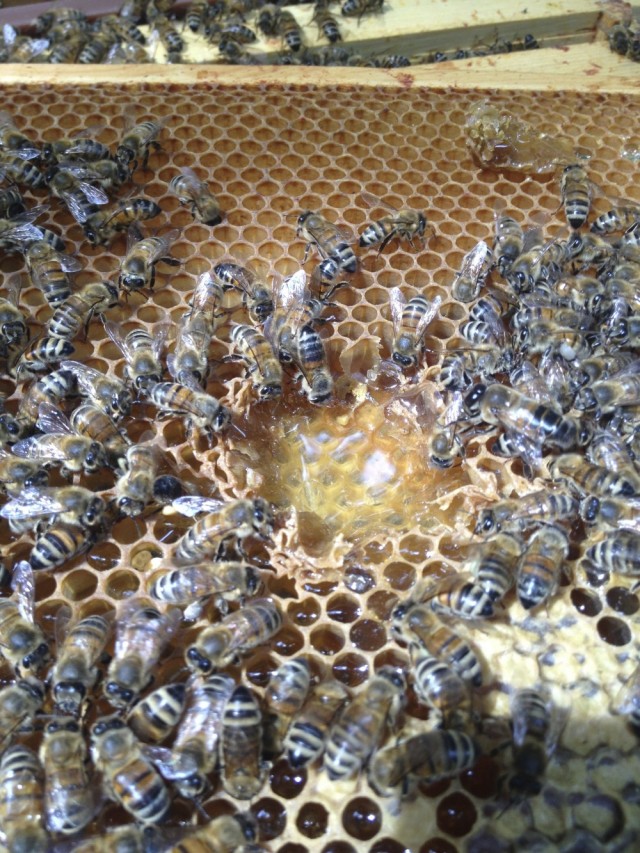
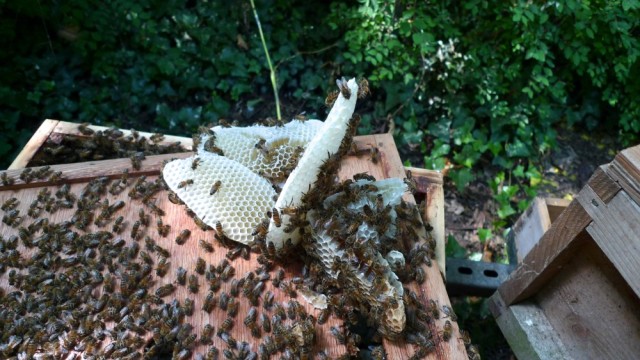
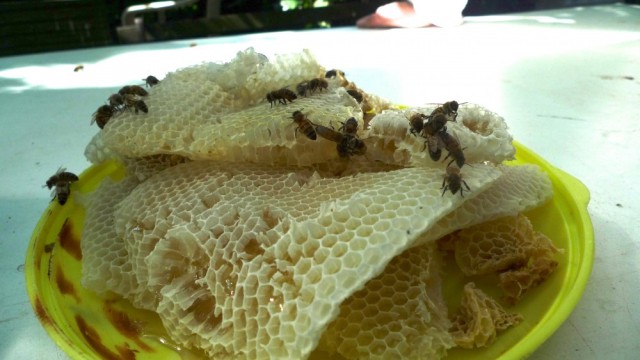
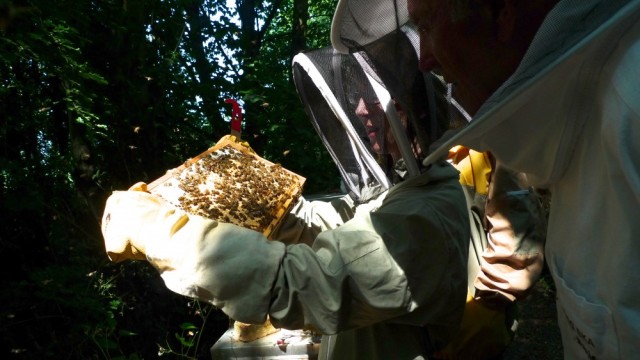
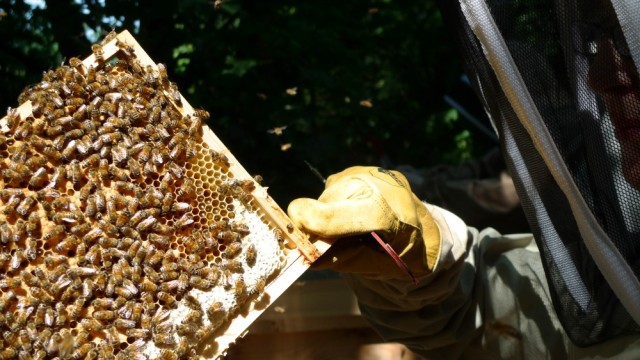


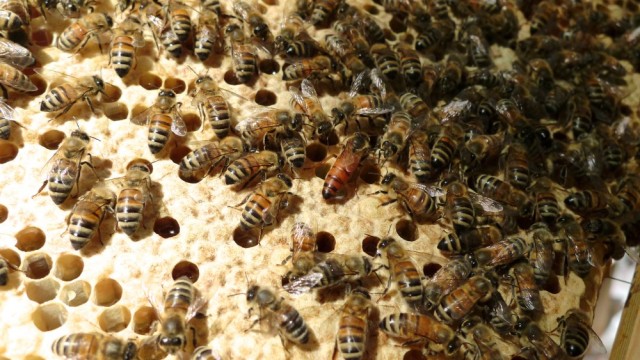
Great post . . . for once, no disaster or near disaster (except for the squashed bees). Almost makes me want to contemplate beekeeping again.
LikeLike
Good! Do you think these photos look better in terms of brightness, or could I push them lighter still?
LikeLike
The photos look good.
LikeLike
Yay.
LikeLike
My like would not load!!!
LikeLike
I’ve been having that problem with WordPress recently too! Especially when I’m on my phone and trying to like other people’s posts.
LikeLike
I like watching, so I could learn without the talking.
LikeLike
If you ever come to London, you’re very welcome to visit the Ealing apiary and watch 🙂
LikeLike
It is good to follow what actually happens rather than what the books say you should do . I have learnt such a lot from your posts and if I do decide to take the plunge I will be a lot more confidently and in the meantime I can talk to my friend Michel who keeps bees and know what is happening.
LikeLike
Ah yes, so much can go wrong between what the books say and what actually happens. Will be exciting if you do keep bees one day.
LikeLike
The swarming process could over time generate hundreds of beehives from one over time I expect if a beekeeper is lucky.
LikeLike
Hmm, yes. Getting three colonies from one is unusual… usually it would be two. But then some years a hive might die out or be too weak to require splitting. Certainly you can very quickly run out of space! If we get all these colonies through the winter I expect we’ll have to sell one or two next year.
LikeLike
I hope you don’t mind my asking a question as it seem to be relevant to this post. I visited some beekeepers in Exeter last week and I saw them clip the queen’s wings, to prevent swarming I think. Do you have a view on whether this is a good idea or not?
LikeLike
Emma and I don’t clip our queen’s wings, but that doesn’t mean to say I think it’s a bad idea. I’d be quite nervous about doing it, in case I accidentally cut a leg off or cut too much wing. It’s definitely a skill and I admire people who can do it. The idea is that a queen with clipped wings cannot leave with the swarm. But by the time she attempts to leave the colony would have produced queen cells anyway, so it only buys you a little time – about 8 extra days before the queen cells would hatch out.
LikeLike
Yes I agree. I also don’t clip Queens wings as it really only stops the main swarm leaving, you will still most likely lose the queen when she tries to fly and ends up on the ground outside the hive. The theory is that the workers will then return to the hive. If I miss a swarm then so be it and hopefully they will find somewhere suitable to live or another beekeeper will catch the swarm!
btw Very nice photos, not so easy in your sunny / shady setting.
LikeLike
Thanks. I brightened some of the photos up on my computer first, as it is such a shady apiary.
LikeLike
What exploits your bees get up to – that’s an extraordinary structure they’ve built. Design soon to be used by Milord Foster for some City extravaganza, no doubt (The Gherkin. The Shard. The… Bee Comb?)
LikeLike
Why not – there’s already a library in Worcester called The Hive! http://www.thehiveworcester.org
LikeLike
Emily, you are a great teacher! Thank you for your patient in teaching us. I know it is not easy. I learned a lot form you! 🙂
LikeLike
Thanks Teresa, that’s very kind of you! Has your little one arrived yet?
LikeLike
We have a little drone called Aleks. He was born on 30 May. Hope to see you on Saturday in Scout Hut! Aleks will come with us 🙂
LikeLike
Well May is the drone season! Sorry I missed you in the Scout Hut, had to inspect our bees. Andy sent me a photo of Aleks for the next newsletter, very cute. A shame you are leaving for Poland, hope you can do some beekeeping there. Are you moving to be closer to your families?
LikeLike
Because of Aleks we had to postpone beekeeping for the next season but next year we won’t have any excuses not to start. We will have my family around to help with babysitting when we need to do the inspections. I hope we won’t forget everything what we’ve learnt till then! 🙂
LikeLike
Sounds good. You can always send emails to Ealing beekeepers if you need to!
LikeLike
Dear Emily,
Your reference back to Glyn Davies on Drone laying queens and 6month requeening in USA reminded me of a comment by Ron Hoskins of Swindon that he thought varroacides were seriously impairing drone fertility.This may be another variable in UK winter hive losses,,an inability to build up in early spring through ineffective matings with wimpy drones!
Alternatively it may be part of a general loss of male fertility in western society due to packaged and processed food and environmental pollution having oestrogenic effects.
Your blog brings a smile to us older beekeepers, Keep on your reading and sharing because nobody knows it all and you are not afraid to ask questions..
LikeLike
Thanks for the encouragement Jonathan 🙂 My fiance is eating a takeaway pizza as I type, perhaps I should warn him about the processed food!
LikeLike
Depends how quickly you want to follow Teresa!
LikeLike
Great stuff guys and you got to do some beekeeping with a movie star 🙂
Love your photos guys…Gary
LikeLike
Thanks Gary! Yes it was good to meet Michael Caine. He says it’s his real name, whereas the more famous Michael borrowed his surname from elsewhere.
LikeLike
Nice photos. You have some beautiful frames of brood and honey.
LikeLike
Thanks. I love seeing healthy brood, it’s such a picture of contentment.
LikeLike
Great photos…I know what you mean about writing vs talking. I do better when I can formulate my thoughts and then write them. If I have to talk while I’m doing something complicated, well, I don’t do either one very well.
LikeLike
Glad it’s not just me!
LikeLike
At least you’ve gotten some nectar and honey from your burr combs, I just wasted my future working bees. Still dealing with guilt here.
LikeLike
That was unlucky – don’t brood on it (sorry for the pun there – it just slipped in!)
LikeLike
Reblogged this on Miss Apis Mellifera and commented:
The story so far – catching up on our adventures in beeland with this lovely post from Emily!
LikeLike
Thanks Emma 🙂
LikeLike
I hadn’t realized you guys were up to five! Respect!
LikeLike